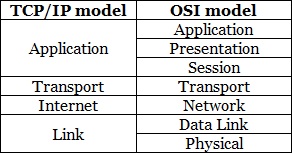TCP/IP reference model
The TCP/IP model is the network model used by computer networks today. It was created in the 1970s by DARPA (Defense Advance Research Project Agency) as an open, vendor-neutral, public networking model. Just like the OSI reference model, the TCP/IP model provides general guidelines for designing and implementing network protocols.
The TCP/IP model has fewer layers than the OSI model, just four. These layers describe different network functions and have their own standards and protocols. The layers are:
- Application
- Transport
- Internet
- Link
Here is a brief description of each layer:
- Link – defines the protocols and hardware required to deliver data across a physical network.
- Internet – defines the protocols for the logical transmission of packets over the network.
- Transport – defines protocols for setting up the level of transmission service for applications. This layer is responsible for reliable transmission of data and the the error-free delivery of packets.
- Application – defines protocols for node-to-node application communication and provide services to the application software running on a computer.
Differences between the TCP/IP model and OSI model
The TCP/IP model and the OSI model are similar in concept, but have a different number of layers, sometimes with different names:
As you can see from the picture above, the Application, Presentation, and Session layers of the OSI model are merged in only one layer – the Application layer, in the TCP/IP model. The Physical and Data Link layers of the OSI model are merged into one layer, the Link layer, in the TCP/IP model.
The following list shows which protocols reside on which layer:
- Application – HTTP, POP3, SMTP
- Transport – TCP, UDP
- Internet – IP
- Link – Ethernet, PPP




